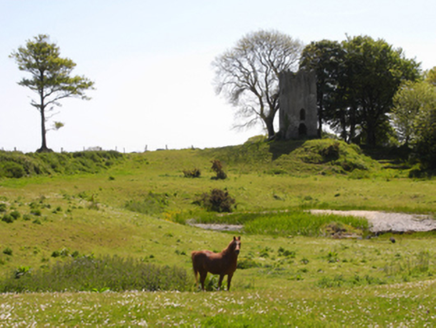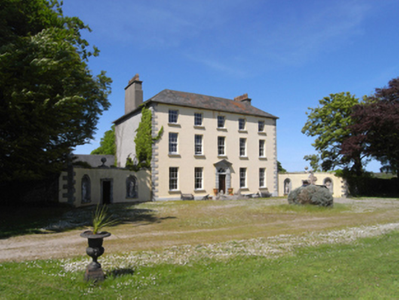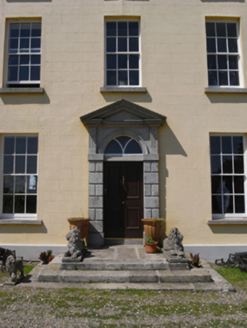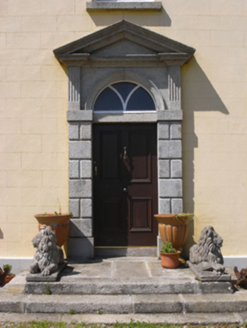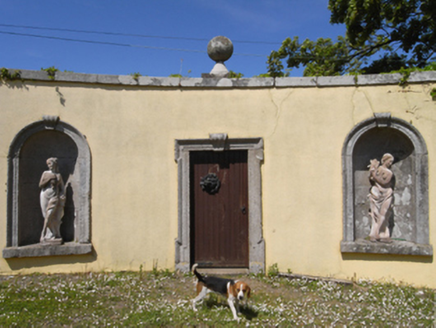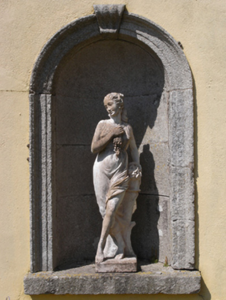Survey Data
Reg No
15702732
Rating
Regional
Categories of Special Interest
Architectural, Artistic, Historical, Social
Original Use
Country house
In Use As
Country house
Date
1750 - 1755
Coordinates
311918, 135126
Date Recorded
03/10/2007
Date Updated
--/--/--
Description
Detached five-bay three-storey country house, built 1753, on a T-shaped plan; single-bay (single-bay deep) full-height central return (north). Vacant, 1863. Occupied, 1901; 1911. Hipped slate roof on a quadrangular plan centred on hipped slate roof (north), clay ridge tiles, rendered, ruled and lined buttressed chimney stacks having cut-granite "Cavetto" capping supporting crested terracotta tapered pots, and cast-iron rainwater goods on rendered slate flagged eaves retaining cast-iron octagonal or ogee hoppers and downpipes. Rendered, ruled and lined wall to front (south) elevation on rendered chamfered plinth with rusticated cut-granite quoins to corners; rendered "sweeps" with ball finial-topped lichen-spotted cut-granite coping; part creeper- or ivy-covered roughcast surface finish (remainder). Round- or segmental-headed central door opening approached by flight of three cut-granite steps with cast-iron "griffin" bootscrapers, cut-granite doorcase with rusticated pilasters supporting ogee-detailed pediment on fluted dosserets framing timber panelled door having fanlight. Square-headed window openings with cut-granite sills, and inscribed surrounds centred on keystones framing six-over-six or three-over-six (top floor) timber sash windows. Square-headed door openings between statue-filled round-headed niches ("sweeps") with cut-granite lugged surrounds centred on fluted keystones framing timber boarded doors. Square-headed window openings in tripartite arrangement to rear (north) elevation with cut-granite sills, timber mullions, and concealed dressings framing six-over-six or three-over-six (top floor) timber sash windows having two-over-two or one-over-two (top floor) sidelights. Interior including (ground floor): central hall retaining carved timber surrounds to door openings framing timber panelled doors, and plasterwork cornice to ceiling; and carved timber surrounds to door openings to remainder framing timber panelled doors with carved timber surrounds to window openings framing timber panelled shutters. Set in landscaped grounds with rendered piers to perimeter having statue-topped cut-granite capping supporting spear head-detailed wrought iron double gates.
Appraisal
A country house erected by Mathew Talbot (d. 1795) representing an important component of the mid eighteenth-century domestic built heritage of County Wexford with the architectural value of the composition, one annotated as "Castle Talbot [of] Talbot Esquire" by Taylor and Skinner (1778 pl. 144), confirmed by such attributes as the deliberate alignment maximising on scenic vistas overlooking gently rolling grounds and a wooded artificial lake; the symmetrical footprint centred on a Classically-detailed doorcase demonstrating good quality workmanship in a silver-grey granite; and the diminishing in scale of the openings on each floor producing a graduated visual impression. Having been well maintained, the form and massing survive intact together with substantial quantities of the original fabric, both to the exterior and to the interior, including some crown or cylinder glazing panels in hornless sash frames: meanwhile, contemporary joinery; and plasterwork refinements, all highlight the artistic potential of the composition. Furthermore, adjoining walled gardens (----); adjacent outbuildings (----); and a folly-like tower 'some years since improved [with] its summit surmounted by embattled ornaments' (Lacy 1863, 501), all continue to contribute positively to the group and setting values of a self-contained estate having historic connections with the Talbot family including William Talbot JP (1765-1849) and Mathew Talbot (1787-1838) '[of] Castle Talbot' (Lewis 1837 II, 139); Major William Talbot (1789-1861) '[who was] an unsuccessful claimant of the Earldom of Shrewsbury in 1856-7' (Walford 1913, 625); and John Hyacinth Talbot JP DL (1852-1920), 'Landowner' (NA 1901; NA 1911; Calendars of Wills and Administrations 1920, n.p.).
